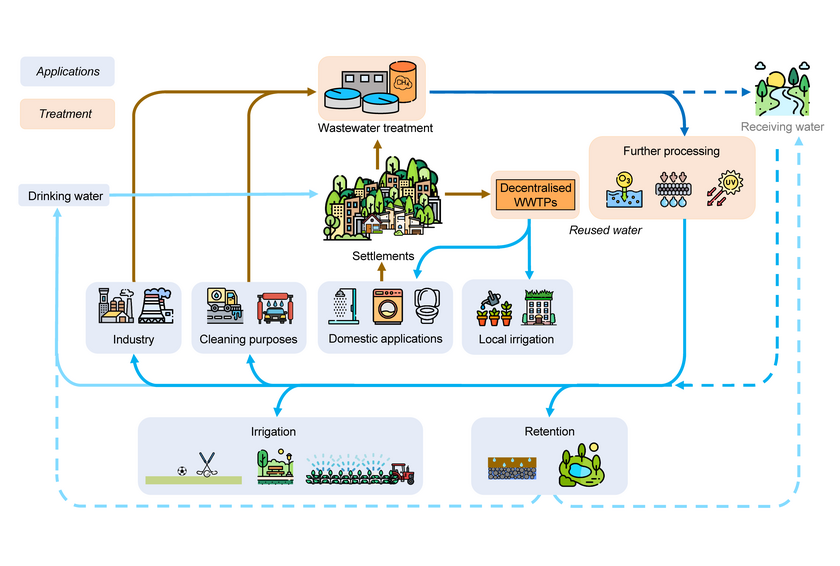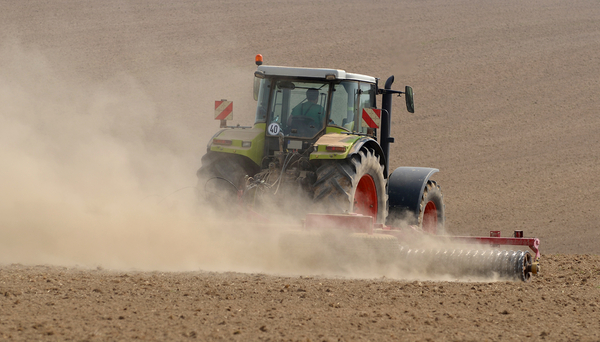News Detail
Dry summers: reusing treated wastewater could help
October 17, 2024 |
Switzerland is often considered the “moated castle of Europe”. But the hot, dry summers of recent years have shown that even in our water-rich country, water can occasionally become scarce in some regions. Due to climate change, such situations will become more common. In addition to the scarcity of water supply, demand for water also increases during such periods, for example for irrigation in agriculture or for cooling. The sustainable management and use of water resources is needed to prepare for the future. As part of the recently completed “Water Reuse in Switzerland” project, the aquatic research institute Eawag investigated whether the reuse of treated domestic wastewater could also be an option. This water would be available for irrigation of agricultural and green areas, for household use in washing machines and for toilet flushing, or for use in industry as cooling and process water. This reduces the amount of water that needs to be taken from groundwater or surface water to meet demand.

In the USA, Australia, Singapore and southern Europe, where water scarcity is part of everyday life, domestic wastewater has long been treated for reuse – in some case to drinking water quality. In Switzerland, however, this has not yet been an issue. Water reuse where the water seeps away – as in the irrigation of agricultural land – is currently prohibited under water protection legislation. All other uses, such as reuse in buildings, do not pose a problem for water protection, but there is a lack of legal provisions and quality requirements for the protection of human health.
Cantons see a need for water reuse
The EU is already one step ahead here. Its aim is to promote water reuse in the member states. In 2023, an ordinance came into force that enables the reuse of treated urban wastewater for agricultural irrigation and sets out minimum requirements for this. However, it is up to the member states whether they implement this regulation. Germany, France, Italy and Spain, for example, do this, but as of yet, Austria does not.
Whether there is a need for water reuse in Switzerland has been investigated by researchers from the Eawag Process Engineering Department, under the direction of Eberhard Morgenroth, as part of the “Water Reuse in Switzerland” project, which involved a survey of cantonal water authorities. Accordingly, 19 cantons see a need for water reuse for various applications, including irrigation, 13 of them as an emergency measure during dry periods. Only four cantons state that they do not foresee any need for water reuse in their canton.
The project therefore took a closer look at the issue of water reuse in Switzerland, compared supply and demand, identified opportunities and risks, and derived recommendations for action from this basis.
Supply and demand could be well matched
There is a good correlation between the spatial distribution of the locations in Switzerland where treated wastewater is produced and where there is a demand for its reuse. This is because the largest volumes of treated wastewater are produced in the large wastewater treatment plants in the densely populated regions, particularly in the Central Plateau. This is also where most of the potential users of treated wastewater are located – agricultural land, industry, households and urban green areas.
A further initial estimate by the researchers also shows that the quantities of treated wastewater that accumulate in dry weather would be sufficient to cover the current irrigation needs in agriculture and settlements.
According to Eberhard Morgenroth: “Water scarcity is always a local problem. It is therefore necessary to identify the options for water supply that minimise the transport of water and where supply and demand also match in terms of timing.” Depending on the local conditions, the best solution may be the use of conventional water resources, decentralised water reuse in buildings or the use of treated wastewater from centralised wastewater treatment plants.
Dealing with risks
When treated wastewater is reused, it is not returned to the bodies of water, or only at a later stage. The researchers therefore wanted to know whether this could become a problem for the levels in the bodies of water. They investigated what proportion of the water volume in the respective water bodies is contributed by the effluent from the wastewater treatment plants. Their conclusion: at most wastewater treatment plants, it would be possible to reuse wastewater without exceeding the maximum amounts that are legally permitted to be withdrawn from bodies of water. Thus, in most cases, reusing water would not affect the natural functions of the water body. “Nevertheless, it will always be necessary to decide whether water should be reused for other purposes or returned to the bodies of water,” says Eberhard Morgenroth.
Depending on its origin and treatment, treated wastewater may still contain various contaminants. To ensure that reuse is unproblematic for humans and the environment, water quality requirements would therefore have to be defined for each intended use, as is already the case of in some countries. For example, the EU has a tiered system of requirements for the quality of reused water for agricultural irrigation, depending on whether, for example, energy crops or food crops are grown in the field. In the USA, there are established standards for direct reuse in buildings for toilet flushing. According to the researchers, there has to be comprehensive risk management. This begins with the selection of the wastewater treatment plant whose wastewater may be used in the first place, and continues with further treatment steps for the purified wastewater, right up to the specifications for the type and timing of irrigation.
Three questions for Eberhard Morgenroth
Is water reuse an option that can contribute to sustainable water resource management in Switzerland?
Yes, but robust water management requires a range of possible courses for action in the event of water scarcity. In Switzerland, water reuse should be part of the portfolio for sustainable water resource management, along with increasing efficiency in water use and the development of conventional water resources.
What needs to be done next to enable water reuse in Switzerland?
With the growing interest in water reuse, it is important for Switzerland to formulate clear framework conditions and requirements. There are good examples in the EU and beyond from which we can learn how to implement and manage water reuse in practice.
How is Eawag contributing to this?
In the final report on the project, we provide clear recommendations on the next steps to be taken to further develop water reuse in a structured way. Eawag aims to contribute to the development of guidelines and frameworks for water quality, operation and monitoring of water reuse facilities, as well as to the further development of robust water treatment technologies. We also want to study the conditions under which the population accepts the reuse of treated wastewater and to compile experiences from existing pilot projects in Switzerland. Eawag has an excellent international network in the field of water reuse and is currently further expanding its expertise in this area.
The Federal Council is drawing up a national water strategy
At present, the cantons are responsible for water management. Strategies for water management already diverge widely from canton to canton. In the 2024 summer session, parliament has now included the development of a national strategy as a legislative goal for the period up to 2027. As part of its efforts to adapt to climate change (target 25), the Federal Council will adopt a strategy as measure 127 entitled: “Water management – droughts, heavy precipitation, quality of water supply, protection of aquatic habitats”. The background to this is the dry summer of 2022 and the realisation in politics that priorities will increasingly have to be set when water is scarce, for example between the interests of industry, households, agriculture and energy production. By prioritising water usage, the cantons can ensure that water needs are met and that aquatic ecosystems are protected. “It is inconceivable that every canton should act according to its own formula; coordination is essential,” said Céline Vara (Greens, Neuchatel), a member of the Council of States.
Cover picture: The use of treated municipal wastewater to irrigate agricultural land has been permitted in some of Switzerland’s neighbouring countries since 2023 (Photo: Adobe Stock).
Original publication
Funding / Partnerships
- Eawag
- Federal Office for the Environment (FOEN)
- Office of Waste, Water, Energy and Air of the Canton of Zurich
- Canton of Bern Office for Water and Waste
- Canton of Solothurn Office for the Environment
- Directorate-General for the Environment of the Canton of Vaud


